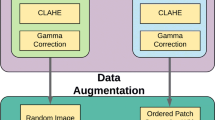Abstract
The accurate vessel segmentation for retinal image is the most conducive to early diagnosis of various eye-related diseases. Most deep learning models are used to segment the vessel by green channel grey image and random sampling of whole image that lead to insufficient training samples and low accuracy probably. To address this issue, a novel retinal vessel segmentation model based on deep learning is proposed, which is called Multichannel U-Net (M-UNet) combined with multi-scale equalization sampling for extracting vessel networks. The multi-scale equalization sampling patches are used to splice an image as new data. And the M-UNet structure is utilized to train the retinal vessel segmentation model. The input of the model is the three channel image replacing the grey image. The DRIVE and STARE database are used to evaluate the performance. Experimental results indicate that the proposed method can obtain better vessel networks, especially for the extraction of peripheral vascular structure. The average accuracy of DRIVE is 0.9716, sensitivity is 0.8168, specificity is 0.9860, and Area Under Curve (AUC) is up to 0.9843. The performances are more competitive than state-of-the-art methods.







Similar content being viewed by others
References
Staal, J., Abramoff, M.D., Niemeijer, M., Viergever, M.A., van Ginneken, B.: Ridge-based vessel segmentation in color images of the retina. IEEE Trans. Med. Imag. 23, 501–509 (2004)
Yan, Z., Yang, X., Cheng, K.T.: A three-stage deep learning model for accurate retinal vessel segmentation. IEEE J. Biomed. Health Inf. 23, 1427–1436 (2019)
Ricci, E., Perfetti, R.: Retinal blood vessel segmentation using line operators and support vector classification. IEEE Trans. Med. Imag. 26, 1357–1365 (2007)
Lupascu, C.A., Tegolo, D., Trucco, E.: FABC: retinal vessel segmentation using AdaBoost. IEEE Trans Inf Technol Biomed 14, 1267–1274 (2010)
Soares, J.V., Leandro, J.J., Cesar, R.M., Jr., Jelinek, H.F., Cree, M.J.: Retinal vessel segmentation using the 2-D Gabor wavelet and supervised classification. IEEE Trans. Med. Imag. 25, 1214–1222 (2006)
Maninis, K. K., Pont-Tuset, J., Arbeláez, P., Gool, L. V.: Deep Retinal Image Understanding, in International Conference on Medical Image Computing and Computer-assisted Intervention, (2016)
Liskowski, P., Krawiec, K.: Segmenting retinal blood vessels with deep neural networks. IEEE Trans. Med. Imag. 35, 2369–2380 (2016)
Ronneberger, O., Fischer, P., Brox, T.: U-Net: convolutional networks for biomedical image segmentation (2015)
Xue, L.: A saliency and Gaussian net model for retinal vessel segmentation. Front. Inf. Technol. Electron. Eng. 20, 1075–1086 (2019)
Wu, Y., Xia, Y., Song, Y., Zhang, D., Cai, W.: Vessel-Net: retinal vessel segmentation under multi-path supervision, in International Conference on Medical Image Computing and Computer-Assisted Intervention (2019)
DRIVE: digital retinal images for vessel extraction, http://www.isi.uu.nl/Research/Databases/DRIVE, (2004)
Odstrcilik, J., Kolar, R., Budai, A., Hornegger, J.: Retinal vessel segmentation by improved matched filtering: evaluation on a new high-resolution fundus image database. IET Image Proc. 7, 373–383 (2013)
Azzopardi, G., Strisciuglio, N., Vento, M., Petkov, N.: Trainable COSFIRE filters for vessel delineation with application to retinal images. Med Image Anal 19, 46–57 (2015)
Li, Q., Feng, B., Xie, L., Liang, P., Zhang, H., Wang, T.: A cross-modality learning approach for vessel segmentation in retinal images. IEEE Trans. Med. Imag. 35, 109–118 (2016)
Li, M., Ma, Z., Liu, C., Zhang, G., Han, Z.: Robust retinal blood vessel segmentation based on reinforcement local descriptions. Biomed. Res. Int. 2017, 2028946 (2017)
Yan, Z., Yang, X., Cheng, K.T.: Joint segment-level and pixel-wise losses for deep learning based retinal vessel segmentation. IEEE Trans. Biomed. Eng. 65, 1912–1923 (2018)
Noh, K.J., Park, S.J., Lee, S.: Scale-space approximated convolutional neural networks for retinal vessel segmentation. Comput. Methods Progr. Biomed. 178, 237–246 (2019)
Jiang, Y., Wang, F., Gao, J., Liu, W.: Efficient BFCN for automatic retinal vessel segmentation. J. Ophthalmol. 2020, 6439407 (2020)
Acknowledgements
This work is supported by the Natural Science Foundation of Fujian Province (Grant No. 2020J01573), Educational Science and Planning Project of Fujian Province (FJJKCG20-178).
Author information
Authors and Affiliations
Corresponding author
Additional information
Publisher's Note
Springer Nature remains neutral with regard to jurisdictional claims in published maps and institutional affiliations.
Rights and permissions
About this article
Cite this article
Dong, H., Zhang, T., Zhang, T. et al. Supervised learning-based retinal vascular segmentation by M-UNet full convolutional neural network. SIViP 16, 1755–1761 (2022). https://doi.org/10.1007/s11760-022-02132-3
Received:
Revised:
Accepted:
Published:
Issue Date:
DOI: https://doi.org/10.1007/s11760-022-02132-3




